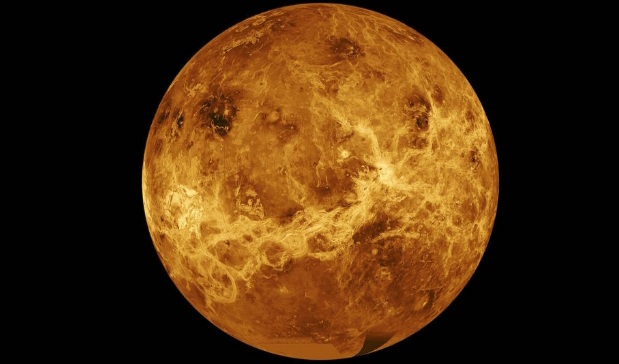**** Info via Environment Canada
Visiting Venus
Venus, the second planet from the Sun, is named after the Roman goddess of love and beauty. As the brightest natural object in Earth’s night sky after the Moon, Venus can cast shadows and can be, on rare occasions, visible to the naked eye in broad daylight. Sometimes called “the Morning Star” or “the Evening Star” Venus shines so brightly that it is the first “star” to appear in the sky after the Sun sets, or the last to disappear before the Sun rises.
Venus. Thought to hide a wealth of information that could help us better understand Earth, and other exoplanets. This image is a composite of data from NASA’s Magellan spacecraft and Pioneer Venus Orbiter. Credits: NASA/JPL-Caltech.
NASA has announced two new missions to explore Venus, as this planet is remarkably similar to Earth in size and mass. And although it is a hellishly hot, inhospitable world today, it may once have been a temperate, ocean-covered planet like our own. Understanding how Venus became such an extremely unfriendly world is crucial for understanding how common truly Earth-like planets might be.
Mission 1: DAVINCI+ (Deep Atmosphere Venus Investigation of Noble gases, Chemistry, and Imaging).
DAVINCI+ will measure the composition of Venus’ atmosphere to understand how it formed and evolved, as well as determining whether the planet ever had an ocean. Instruments will plunge through the planet’s thick atmosphere, making precise measurements of gases and other elements to understand why Venus’ atmosphere appears to have experienced a runaway greenhouse effect. A runaway greenhouse effect happens when heat is trapped on the planet, preventing it from cooling and from having liquid water on its surface.
Observations suggest Venus may have had water oceans in its distant past. A land-ocean pattern like that above was used in a climate model to show how storm clouds could have shielded ancient Venus from strong sunlight and made the planet habitable. Credit: NASA
Measurements by NASA’s Pioneer mission to Venus in the 1980s first suggested Venus originally may have had an ocean. However, Venus is closer to the sun than Earth and receives far more sunlight. As a result, the planet’s early ocean evaporated, water-vapor molecules were broken apart by ultraviolet radiation, and hydrogen escaped to space. With no water left on the surface, carbon dioxide built up in the atmosphere, leading to the so-called runaway greenhouse effect that created the present conditions on Venus.
Mission 2: VERITAS (Venus Emissivity, Radio Science, InSAR, Topography, and Spectroscopy).
Proposed for a 2026 launch, VERITAS would orbit the planet and peer through the obscuring clouds with a powerful state-of-the art radar system to create 3D maps to help figure out what the surface is made of. It would also measure the planet’s gravitational field to determine the structure of Venus’ interior.
This artist’s concept shows the proposed VERITAS spacecraft using its radar to produce high-resolution maps of Venus’ topographic and geologic features. Credit: NASA/JPL-Caltech.




